In theory, it is possible to grow any vegetables in containers, if a large enough container is used. This may not be practical as the return from some vegetables in containers is so small.
It makes sense to concentrate on high-value crops, the crops which are harder to find in shops or are very expensive to buy. One myth that is often spread is that home grow vegetables taste better than shop bought. This is not true, sometime it will taste better, other times it will taste inferior. Do not always believe what the seed merchant tells you.
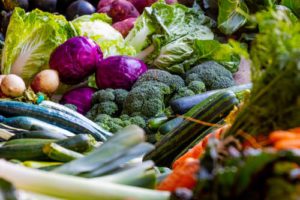
The first rule of vegetable container gardening is to grow the crops you like. The second rule is to choose varieties that are suitable to be grown in containers, so check that they say on the seed packet or in the catalogue ‘suitable for close spacing’ or ‘mini’, or ‘suitable for container growing’. The third rule is to make sure that the right size of container is used, filled with the right type of compost.
For beginners, I would start with easy to grow vegetables and these include come and cut again lettuce, radishes, spring onions, tomatoes, potatoes and cucumber. They are not only good to eat, but also not difficult to grow. Radishes are a good way of getting children involved in gardening, as they are such a quick crop.
The time taken between seed sowing and harvesting the radishes is no more than 5-7 weeks. Potatoes are very easy to grow in containers, and who does not new potatoes covered in butter and parsley. Children also like looking for the treasure of its small potatoes, so another tool to get children gardening.
WHAT VEGETABLES CANNOT BE GROWN IN CONTAINERS
The following vegetables are not suitable to be grown in containers:
- Artichokes, Global- A member of the thistle family that produces a very large plant that grows to 1.5m in height and width, This is far too big for most containers where you would obtain far too little.
- Artichokes, Jerusalem- They produce masses of foliage where it grows up to 2.5m high, As all the growth is on top, but not many tubers at the bottoms as only 1kg is produced. A lot of effort for such little reward.

Jerusalem Artichokes a crop that cannot be grown in containers.
- Asparagus- A large area of 3 metres square is required to produce enough spears to feed a family. It is also shallow rooted and delicate, so I would not grow them in containers as it is not worthwhile.
- Broccoli/Calabrese- Most broccoli are large plants, taking up a lot of room, and needing a lot of space between them. This would mean to get a decent crop, a lot of large containers will be required, and thus will be impractical for most container gardeners. This does not mean all brassicas cannot be grown in containers but some calabrese-types can be successfully grown. This will be discussed later on.
- Brussels sprouts- Love them or hate them, they are a slow growing crop that takes up a large area. This can only be accomplished if you decide to grow one specimen per large pot, so in all case not very viable.

Brussels sprout delicious but cannot be grown in containers
- Celeriac- This root crop has celery-like taste but it occupies too much area as it cannot be grown at close spacing. Theoretically, it can be grown one per container, but if you want a decent crop this is so unsatisfactory.
- Celery- This vegetable prefers the soil to be very wet. It takes so much water to grow one, with 120litres per plant per week not being unheard off. They do not like being planted close and so you can only manage one plant per pot. This and the high watering rates makes growing celery in containers not very practical.
- Garlic- This herb can be grown one per 20cm diameter pot but you must think to yourself, is it worth it. All the compost involved and the expense of buying multiple pots makes it unsuitable to grow in containers. In a bed yes, in a container no.
- Kale- This large brassica is not suitable to grow in containers as the plants are too large. As one plant per large pot makes it very expensive to produce a decent crop.

Kale plant another vegetable that cannot be grown in containers
- Onions and Shallots- These versatile vegetable are not worth growing in pots, as like garlic in need a 20cm diameter pot to produce one bulb. Growing enough to feed a family is totally impractical, time-consuming and costly.
- Squashes- All summer (apart from courgettes and cucumbers) and winter squashes grow to large proportions and therefore not viable to be grown in containers. There require too much water and feeding. This includes all mixed varieties.

Squash plants are generally too big for containers
- Swede- As this root crop need large spacing (20cm between plant) to produce one swede. It can be seen that it is not practical or worthwhile to produce enough crop for one family.
- Sweetcorn- As this is such a tall plant, which has a large appetite, makes it unsuitable to grow in containers including the mini varieties. Growing 1 plant per container at a spacing of 30cm between each plant, seems to be very wasteful.
WHAT CAN BE GROWN IN CONTAINERS
Now that I have told you what vegetables cannot be grown or should not be grown in containers. It has come to the exciting part to tell you what vegetables can be grown in containers:
AUBERGINE
This vegetable is really a greenhouse crop in the UK, although you can risk growing outside in a container if a hot, sunny summer occurs. Aubergines are tasty and usually used in many Mediterranean dishes from Moussaka to melanzane alla parmigiana.
You can start the seeds in a seed tray in February/early March in a heated propagator. Heat is necessary otherwise the seed will not germinate in a reasonable time frame. Once they are big enough to handle, you can transplant into 8cm pots. Keep them indoors in a sunny window sill until the last frost has passed.
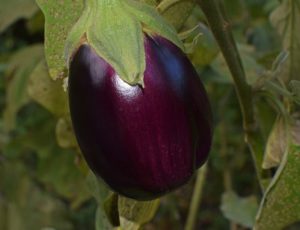
They are not large plants but the weight of the fruits can break branches, so they will require propping up with small canes. They are fairly easy to grow as only heat is their main requirement.
The purple flowers when they appear may require misting in order for the aubergine to produce fruit, as this aids pollination in the self-fertile plant.
Aphids and red mite can be a problem, but spraying with water seems to deter them. They also do not cause much damage. Remember to pick aubergine before the shine disappears, as this is a sign that the fruit is over ripe.
BROAD BEANS
Usually, broad beans are unsuitable to grow in containers, as large amounts of space are required to produce such little crop.
But the development of dwarf varieties such as ‘The Sutton’ and ‘Robin Hood’ has been developed, which make container planting suitable. Broad beans can either be grown directly in the container or be grown in seed tray/root trainers.
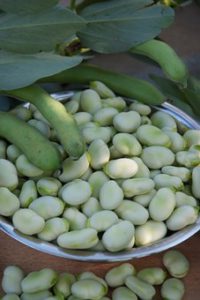
With root trainers, no root disturbance will take place, but with seed trays, the roots can become intertwined, which could kill the plant if the roots are damaged too much. The seedlings are ready to plant when the roots start poking out of the root trainer.
A large container is required so that at least 6 plants per pot can be achieved. This will ensure that insects will pollinate the flowers and pods will be produced. As broad beans get their own nitrogen from nodules in the roots, then they do not need feeding with a high nitrogen fertilizer, but would appreciate a high potassium feed such as tomato fertilizer.
DWARF FRENCH BEANS
These plants are ideal for container growing as they do not generally grow more than 45cm tall. Many varieties exist and do well in close spacing. The tepee varieties are normally recommended, in that the beans are produced on the outside of the foliage, making picking easier.
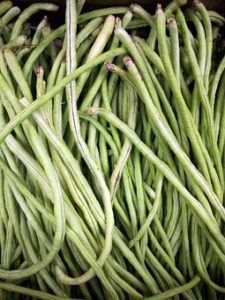
The tepee varieties come in many colours from green, yellow and purple. They grow fairly fast and so can be planted directly in the container or like broad beans they can be planted in root trainers, or 8cm pots. Once the plants have developed, then they can be transplanted to its final growing position. As with any type of bean, they appreciate a feed of tomato fertilizers to aid pod production.
CLIMBING FRENCH BEANS/RUNNER BEANS
These climbers produce a lot of beans for a small amount of growing space they take up. You can train them to grow up canes, netting or trellises and are good to hide ugly bare walls.
They grow tall up to 2.5m in height, and you will need to pinch the growing tips when they reach the top of their canes. This will encourage them to bush out and produce more beans lower down.
They can be sown directly in the container but they do better if they are planted in 8cm pots or root trainers. The beans need to be planted 15cm apart, so you can grow them in a wigwam structure, planting one plant at the circumference of the large container.
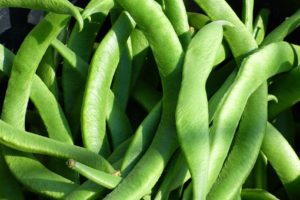
As these climbers produce a lot of leaves, then in containers it will require plenty of water to stop it from wilting.
Runner beans can be grown in large half wooden barrels (1.2m high and 1m deep) using the wigwam system or they can be grown a few plants in 18cm pots. You may need a drip irrigation system to prevent excessive watering requirements, or be prepared to water 3 times a day in hot weather.
Hestia is a dwarf runner bean that can be grown successfully in containers, up to six plants per container. The container size will determine how many runner beans can be grown within the container. A larger container can support more runner bean plants.
All climbing beans in containers would appreciate a feed of tomato fertilizer regularly, in order to help pod production.
BEETROOT
All globe varieties of beetroot are suitable for close spacing in containers. It is best to harvest when they are golf ball size, so you can space them quite close with a 10cm gap between plants.
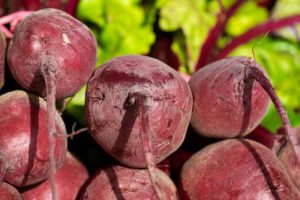
Beetroot seeds are unusual as they are in fact a number of seeds in one seed cluster, so thinning is always required, to one seedling per station. Some varieties are monogerm, having one seed per seed cluster, making thinning unnecessary.
If you do not want to plant directly in the container, you can alternatively plant in modules (you can have more success using this way) and then transplanting the plugs into containers. ‘Boltardy’ and ‘Kestrel’ are the normal recommended variety for reliability and yield.
BROCCOLI VARIETIES
As said previously most broccolis are not suitable to grow in containers but they are exceptions, and these are Kabuki and Sakura.
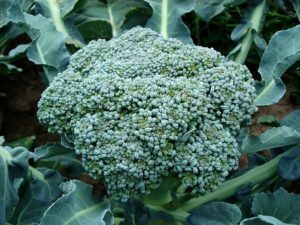
You need to start them in small pots in April/May, then transplant the young seedling into larger pots, when they are big enough to handle. In July, it can be moved and planted in its final position of a 30cm diameter container, before harvesting in October or November.
CABBAGE
There are a number of compact varieties of cabbage that can be grown in containers, The advantage of a smaller cabbage is that it will grow to the right size to feed a family of three or four, thus reducing a lot of wasted cabbage.
Minicole is an excellent cabbage for container growing and is very useful when making coleslaw. Hispi is slightly larger but still can be used to grow in containers, as it is a pointy variety, and therefore grows upwards instead of outwards. It also matures very quickly. Other pointy varieties that can be grown in containers are Pixie and Samantha. April, Candisa and Durham Early will also tolerant close spacing.
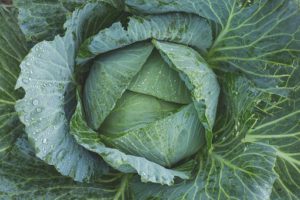
All cabbages are best started in modules, before transplanting them into 8cm pots. Once the cabbage has produced 6 or 8 true leaves then the cabbage can be transplanted to its final position in the container. Brassicas hate acidic soil, so plant them in enrich multipurpose compost. During the growing season feed with a high nitrogen fertilizer such as sulphate of ammonia to produce new leafy growth.
Cabbages prefer to be fed regularly, at 2 weeks intervals as they are a hungry crop.
CARROTS
Growing carrots in containers normally require a tall container, as carrots have a long taproot. The depth of this container is so much dependent on the variety of carrot that you wish to grow. For long carrots, 30cm depth is required, but for intermediate carrots, you can get away with 15cm of depth. For round varieties, only 8cm of depth will be sufficient.
A lot of people like growing carrots in containers, as this will give you control of the medium you want to grow in. Long carrots tend to fork in the ground because the root has hit a stone and it tries to bypass it. Forking is also caused if the soil had been recently manured. You get some funky shaped ones if you use this method. Carrots also hate heavy, clay soils.
The growing media for growing carrots is different from normal vegetable growing compost. Carrots prefer sandy soil, and for your homegrown roots, a mixture of 70% by volume of multipurpose compost with 30% sand (I use play sand) is recommended.
You can add a general fertilizer such as fish, blood, and bone to help to feed the carrots at the initial stages. You can feed them a feed of tomato fertilizer at one-month intervals to get them growing well.
Carrots come in two types; early and main. Early varieties tend to be short and quick growing, whilst main carrots are larger and more slowly growing. Carrots, apart from the short round varieties, hate being transplanted, and therefore the seeds must be planted in-situ.
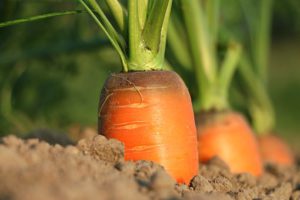
All you need to do is scatter the seeds thinly across the surface of the container and then cover lightly with some more compost. Carrots are notoriously slow to germinate, taking up to 17 days, so be patient.
Once the seedling emerges, thin to about a gap of 2cm between them. As they grow you can eat the small thinnings, until a spacing of 5cm remains between each carrot. One serious pest of carrots is the carrot root fly. There young cause damage to carrot by tunnelling under the skin of mature carrots, and killing young seedlings.
They are attracted by the smell of carrots, so when you thin, thin in late evenings when the fly is less active. As the fly flies low to the ground (around 45cm high), you can use a barrier such as fleece to protect your precious crop.
Some carrots fly resistant varieties exist, such as Flyaway, which is recommended for areas with high infestations. Some people suggest growing carrots and onions together, as this will confuse the fly, but this is hardly economical for container growing.
CAULIFLOWER
You can grow cauliflower in a 25cm diameter container, growing one per pot, but they do better in raised beds. This plant will get large in containers having a large spread, making close contact between containers difficult.
There are many varieties that are suitable for close spacing such as Igloo, Avalanche, and Latemen. You need to grow them exactly as that’s recommended for cabbages.
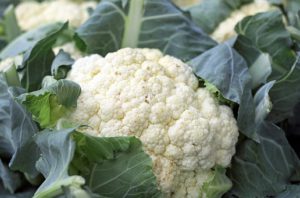
Cauliflowers are a greedy crop and need to be planted in enriched multipurpose compost. It will also need feeding twice a month with a high nitrogen and potassium liquid fertilizer. If you do not feed the cauliflowers, the result would be small heads. Watch out for attacks by caterpillars and hand remove any that you see.
If you have no room, I would give this vegetable a miss.
COURGETTES
This is one member of the squash family that can be grown in containers. They are prolific producers and so only one or two plants per family would be required. Courgettes are another hungry crop and would require weekly feeding with tomato fertilizers, and regular watering.
All you need to do is plant a seed on its side (to prevent the seed from rotting) in an 8cm pot full of multipurpose compost. The best time to do this is mid-April. Once the plant has grown to a decent size, you can then transplant to the container outside in early May, once the last frost has passed.
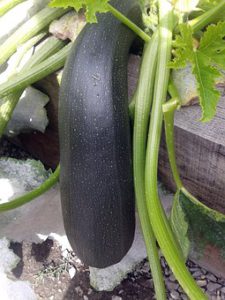
Remember to remove the courgette fruit when young, less than 15cm in length, otherwise, you will have a marrow produced and no more courgettes. There are many varieties suitable for container growing.
The major problem of courgettes is powdery mildew toward September, as this weakens the plant. But at this time you will be sick of eating courgettes and the plant has not much longer to live anyway. At the first sign of attack of powdery mildew, spray the leaves with a mixture of 1 part milk to 4 parts water.
CUCUMBER
These are an ideal container plant because you can train them to grow up canes and netting, making them very prolific for such a small growing area.
Cucumbers have been bred so that some will do better in a greenhouse, whilst others do better outside, in a sheltered sunny spot.
The older varieties produce male and female flowers, which meant that the male flowers had to be removed in order to stop bitter tasting fruits from forming. Modern F1 varieties have removed this laborious task. The seeds are expensive from £4 to £6 for six seeds. This is especially true for the modern F1 varieties. You only need one or two plants to feed a family for the summer. You can store any unused seeds for several years, so they are worth the investment.
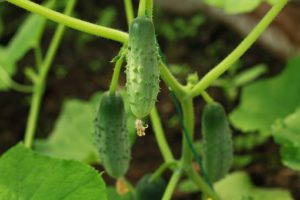
Start off by planting seed sideways in an 8cm pot in multipurpose compost in a sunny window sill. When the roots start pushing out from the bottom, move to a 25cm diameter container. Be warned sometimes cucumber plants do not transplant well and for some unknown reason, they die. Transplant at the right time, as the plants do not like cold days or nights.
Cucumber tends to be disease free but can suffer from mosaic virus, spread by aphids, and powdery mildew, which can be dealt with using the milk mixture highlighted with courgettes.
One serious disease of cucumbers is foot rot, where the plant roots at the junction where it meets the compost. The plant needs a lot of water but hates being wet at that point. To guard against this it is best to water using a watering spike. The funny thing is that the leaves like high humidity, so mist spraying may be necessary. Sun can scald the leaves and so the plant may need some shading in really sunny weather.
When the leading stem has produced 8 leaves, you can pinch its growing tip off, as this will encourage more side shoots to form. Feed using tomato feed at 2 weekly intervals and pick fruit regular. It will stop producing if a cucumber fruit is allowed to turn yellow on the plant.
Long varieties and mini cucumbers exist, so you have a choice of which variety to grow. Mini cucumbers are very prolific producing 30 fruits per plant.
KOHLRABI
This increasingly popular vegetable of the brassica family, looks like a green beetroot, with the leaves growing on the side. It can be eaten raw in salads or cooked.
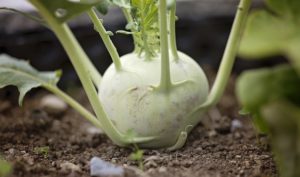
They can grow to large sizes, but best harvested young (golf ball size). This normally takes 8 weeks after planting. It is best sowed directly in the container and thinned to 8cm apart. It looks attractive in containers.
LEEKS
Leeks can be successfully grown in large containers or troughs. Sow the seeds thinly in a large container that is at least 20cm deep, but 30cm is better, in a multipurpose compost in March or April. Feed after six weeks with liquid fertilizer, and then at 3 weekly intervals with a general liquid fertilizer.
If they are overcrowded when the seedlings emerge then thin them, otherwise wait until they are pencil width thick. At this stage, a gap of 8cm between plants is required, with the thinning used in stir-fries.
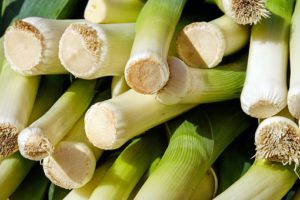
You will then need to make a collar from toilet roll tube innards, to exclude light in order to Blanche (produce the white portion of the leek) the leek. Cut the toilet roll tube in half and then place around the leek, by tying some string, or you can use an elastic band.
Gradually move the collar up the leek as it grows to introduce more blanching. Many varieties exist such as Oarsman, King Richard, Edison, and Carlton, which are suitable for close spacing.
LETTUCE/COME AND CUT AGAIN LEAVES
For ease, come and cut again leaves are the easiest to grow. All you need to do is scatter the seeds thinly on the compost, lightly cover with compost, water and then wait. When you want some leaves, cut off the required amount, make a salad, and leave the rest. The leaves will regrow, up to 3 or 4 times, before it is finally exhausted.
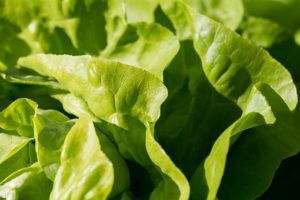
Many ready to made mixes are sold, all have different leafy vegetables in them, so it is left to you to decide your preference.
For those who prefer more standard lettuce head varieties, then you have Tom Thumb, Pinnakio and little gem, all can be closely spaced in a container or window box.
SPRING ONIONS
One of the easiest crop to grow in containers, as they do not take up much room. All you need to do is sow thinly, and then cover lightly with more compost. You will get a crop within 10 weeks, and there is no need to thin. If you want a continual supply then seeds can be sown in 2 weeks intervals, between March and July.
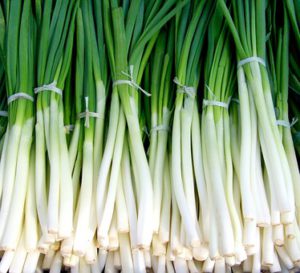
Guardsman is the usual spring onion for containers, but white Lisbon and North Holland Blood can also be grown.
PARSNIP
Parsnips can be grown in a similar way to carrots, using the same compost mixture. The seeds are slow to germinate, taking up to 3 weeks. The seeds must be sown in-situ as otherwise the roots will grow twisted and forked.
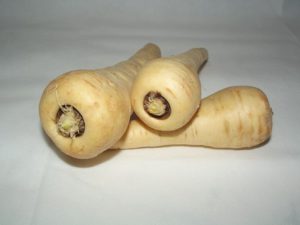
You can thin as you go along, where they would appreciate a 15cm gap between each plant. Closer spacing will result in small, misshaped root being formed.
PEAS
Nothing beats the taste of a fresh pea, and it’s easy to grow. All you need to do is sow directly in a multipurpose compost, wait for them to emerge and then enjoy the pods.
There are two kinds of peas, a dwarf, compact variety and a tall, climbing variety. Compact varieties need to be fed with tomato fertilizer, whilst tall varieties appreciate alternating between tomato and general liquid fertilizers, to keep the leaves going.
You sow in March and then successional through until June. You can start off in modules and then transplant, but the roots grow very quickly and so would need transplanting into containers very soon.
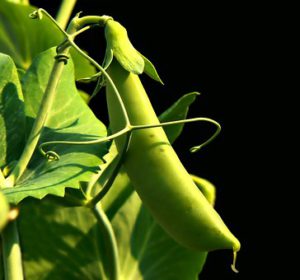
Peas come in three types; First early, Second early and Main Crop. Earlies are better as a crop for containers, as they produce their pods quicker. In seed catalogues you often find them referred to as smooth or wrinkly, and all this means is how the dried seed appears. Wrinkly seeds tend to be sweeter as a general rule.
The container variety half-pint does well in 20cm pots without any support, it grows up to 33cm in height, is bushy and give a good crop of pods. All other dwarf varieties also will do well in containers.
This does not mean that tall varieties cannot be grown in containers but they will need training up canes and netting. All varieties of peas will need plenty of water during the growing season.
SWEET PEPPERS/CHILLI
Both do very well in containers. The trick is to keep them warm and start them early. They prefer the comfort of a greenhouse but can be grown in a sunny, sheltered spot. It is best to start in February in a seed tray in a hot propagator, or on a windowsill in a warm room. When the seedling germinates, transfer them to an 8cm pot when they are large enough to handle.
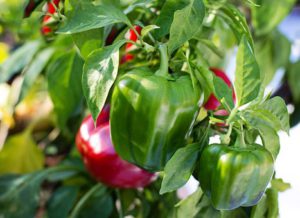
Once the root system starts to show through the bottom of the pot, then they can be transplanted to its final position in a 20cm diameter container.
Peppers are heavy and so heavily fruited plants would appreciate some level of support by tying them to short canes.
When the flowers open you can mist by using water to help the fruit to set, feeding once a week with tomato fertilizer will ensure a heavy crop. Chilies dry well and can be stored up to a year.
POTATOES AND TOMATOES
This will be discussed in a future article because they need a more detailed description.
RADISH
One of the easiest crop to grow in a container, if you have some spare areas in a vegetable container. All you need to do is drop some seeds in, thin, and within 3-7 weeks you will have radishes to eat.
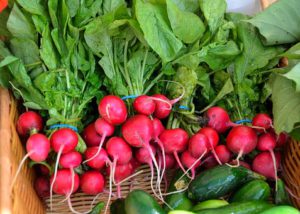
Not a fussy crop, will grow in any compost type. Do not leave too long, as the roots become woody with age. They need to be harvested when a decent size. It can be sown between March and September for a continual supply.
Chinese winter radishes, which are longer (like parsnip size) and they can theoretically be grown in containers, as long as a deep container is used. This is much more effort.
SALSIFY/SCORZONERA
Similar to parsnips but a totally different family. They are not sold in shops as they do not store well. The flavour is considered superior to parsnips. Salsify is referred to the vegetable oyster due to its subtle flavours, whilst scorzonera is similar but black skinned.
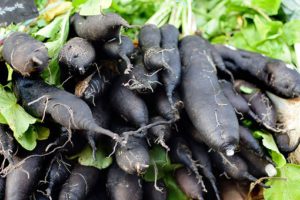
They can be grown in exactly the same way as parsnips. Sow directly in position in late April/early May, using a 15cm spacing between plants. Thinning out to final spacing as the season progresses. Harvest from mid-October.
SPINACH/PERPETUAL SPINACH/SWISS CHARD
True spinach is such a difficult crop to grow, as it will bolt very quickly, so I would not grow it in containers unless you want to harvest as baby leaves. Grow in shade to delay bolting. Start in modules and sow every two weeks in April/early May, and then plant out to a distance of 15cm between plants, for the baby leaves. Thinnings can be used in salads.
Pick from the outside of the plant, allowing the centre to develop. Remember you need a lot of spinach to produce a decent meal.
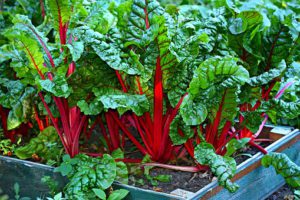
Perpetual spinach and Swiss chard are slower to bolt (but will still do in a hot dry summer). Perpetual spinach is green in colour, whilst Swiss chard can come in a multitude of coloured stems from white, green, orange, yellow, pink, or red. So it looks striking in a container.
Sow directly in a 20cm diameter pots in late April to early June, and then harvest the leaves when required. It will regrow in spring the following year, so do not be too hasty to throw them away at the end of the season. The leaves can be cooked like spinach, whilst the stalk can be cooked like celery. It is a dual-purpose crop.
TURNIP
The last vegetable that can be grown in containers is the turnip. The recommended harvest time is when they reach golf ball in size.
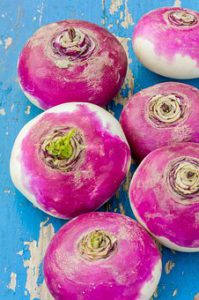
Atlantic and Tokyo cross turnips are recommended to grow in containers, as they have been bred to be picked whilst they are young.
Sow directly and then thin to 4cm apart from April to the end of July. You can sow every two weeks to have a continual supply of turnips to eat.
CONCLUSIONS
In this article, the growing of vegetables in containers have been discussed from soil preparation to vegetables that can and cannot be grown. As you can see there are numerous varieties that can be grown, enough to feed an army with different tastes and textures. There is always a vegetable for you.
If you have any comments or questions that you like to make, please leave them in the comment box below
Bon appetite.

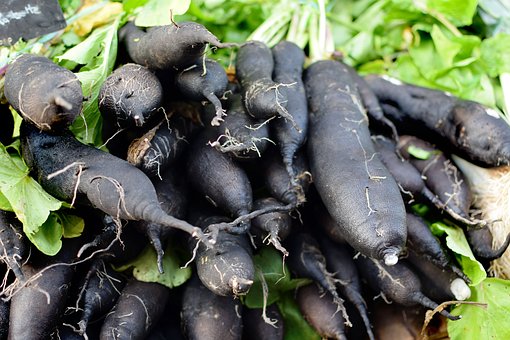
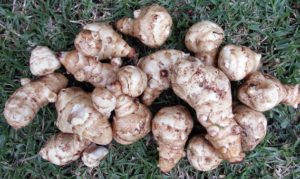
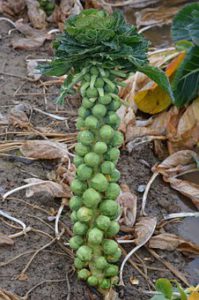
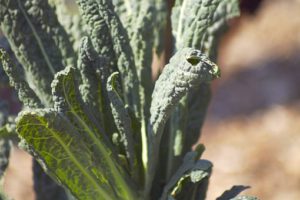
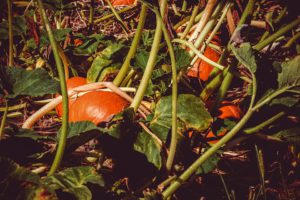
This is an awesomely extensive article! Thanks so much for sharing what vegetables are suitable for container growing! I am lucky that I have a small veggie patch outside, but there are definitely a few things I’d love to grow that just haven’t been thriving outside, and now I know why!
Thank You Josie
I wanted to write an article about veg growing in containers and write it almost as a guide in one place. It is concise and can be used by all veg growers, experienced or novices.
I am glad you enjoyed the article.
Kind Regards
Antonio
This website is filled with great knowledge regarding growing your own vegetables in containers. It is inspiring and something now that my two boys are a little older can help their mom grow food in containers as well!
Thank you for noting which vegetables cannot be grown in containers. This is ideally very helpful for many readers.
Great Antonio. Thank you for sharing this beautiful website with the world/online world. Gardening is very therapeutic for all walks of life!
Will be revisiting again because I am really interested in and have grown trees/ shrubs and plants! This is a wonderful site for future, current and aspiring gardeners for sure!
At this time of year what do you have grown so far in containers? I am curious to know.
Thanks.
Patricia Divine Essence
Hi Patricia
Thank you for those kind words as I believe in growing your own food, especially vegetables is very important.
You can start growing all the vegetables that I recommended in the post, as we are fast approaching thelast frost date. So get planting.
Thanks
Antonio
Really well-structured post! I enjoyed finding out which vegetables were suitable for container growing. I thought that the size of the vegetable was the key factor, but apparently, that’s not the case at all since you can even frow aubergines in containers.
How much would I get on average from a container harvest?
Hi Alex
Thank you for your comment, It is surprising what can be grown in containers, which you though was impossible. All you need to do is give them a try.
The answer to the question you ask is difficult to give, as it depends on the vegetable you are growing, its variety, growing conditions, how much water you give and how well you have looked after it. It can be from a couple of hundred grams from peas to 20kg from potatoes. The rest will be somewhere in between.
Kind Regards
Antonio
Antonio, what a great post! I am planning to go to the garden center tomorrow and I will be on the look out for some containers to grow vegetables in. I think I will go for turnips and radishes as I want those that are easy to grow. My success at growing vegetables in the past have not been great so perhaps I will have more success with them. I haven’t heard of the scorzornera. I like parsnips so if they are regarded as having a better taste to parsnips, I might consider growing them in the future.
Hi James
I wish you all the success for your forthcoming growing your vegetable in containers adventure. Scorzonera is a trendy root vegetable that you tend to find in posh restaurants. The reason it is not sold in shops as it does not store well, and so you have to grow your own.
Good luck with your Veg.
Antonio
This is brilliant! I had never considered you may be able to grow some vegetables in containers. Fantastic for when you do not have the outdoor space.
Although you do let us know which vegetables are not able to grow in containers there are a few that can be.
I am going to give the spinach a go.
I have booked marked this page for future reference, thanks so much!
Hi Dianne
I have tried to be as detail as possible to what can be grown in containers and what should not be attempted, as it is not worthwhile. Spinach is very prone to bolting, and so if you plant it in the container, water regularly and do not space them too close.
Thank you for your comment.
Antonio